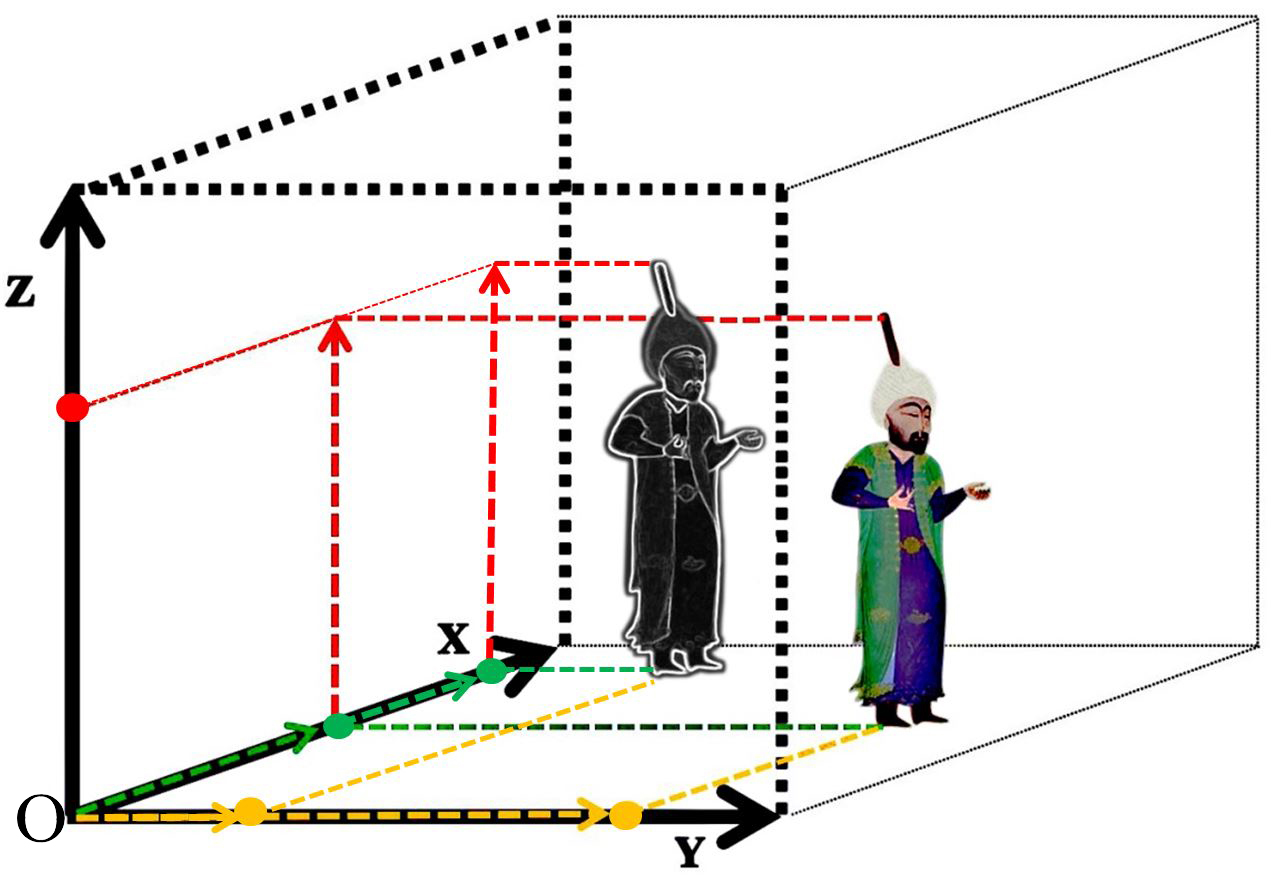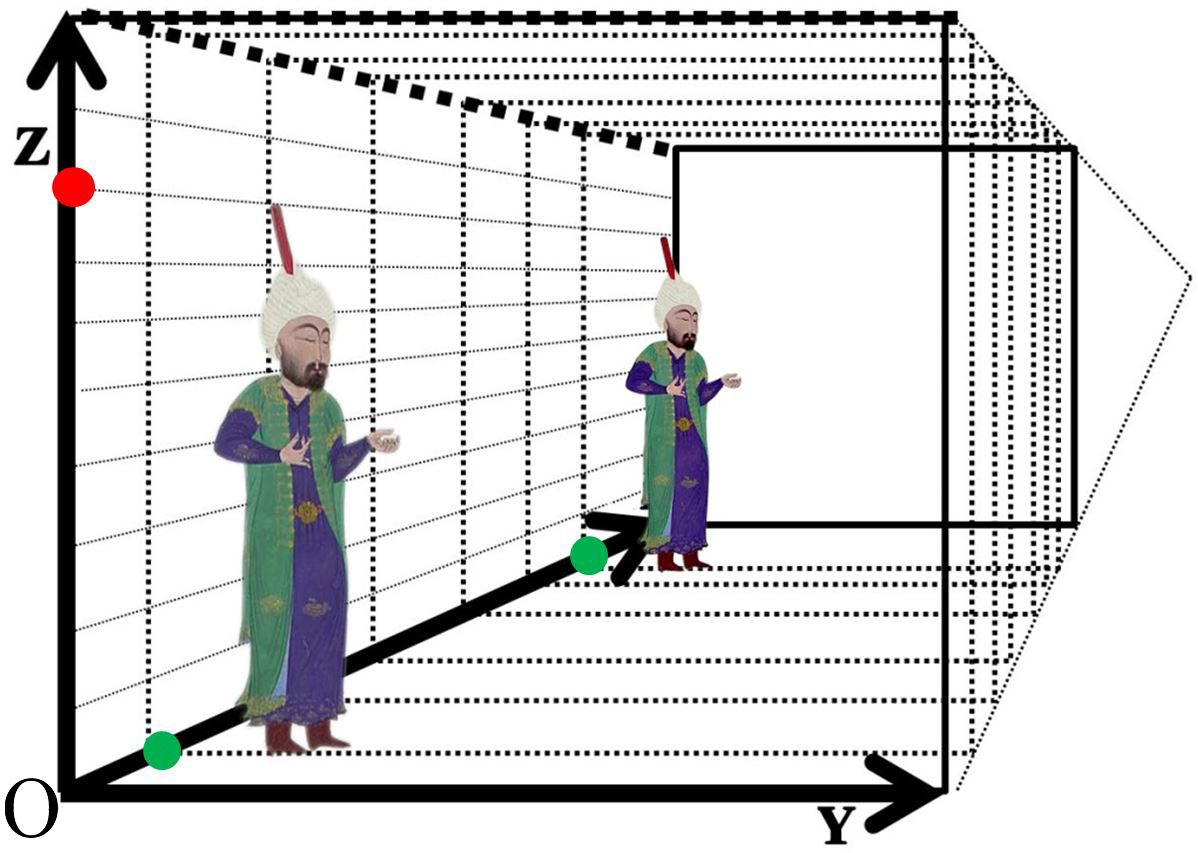
ارثنگ (Arthang)
تاریخ هنر (گزیدۀ 'گفتارها، یادداشتهای پراکنده، مقاله و پژوهشها)
ارثنگ (Arthang)
تاریخ هنر (گزیدۀ 'گفتارها، یادداشتهای پراکنده، مقاله و پژوهشها)بازنمایی ساختمان در نقاشی ایرانی و نقش آن در گستردگی فضای تصویر و ژرفانمایی
مقالۀ «بازنمایی ساختمان در نقاشی ایرانی و نقش آن در گستردگی فضای تصویر و ژرفانمایی» در نشریۀ مبانی نظری هنرهای تجسمی منتشر شد.
نویسنده: مریم کشمیری؛ استادیار گروه نقاشی دانشگاه الزهرا
نشریۀ مبانی نظری هنرهای تجسمی، دورۀ ۸، شمارۀ ۲؛ صفحات ۴ تا ۲۴.


اصل مقاله را از اینجا دریافت کنید.
چکیده
ساختمانها پس از پیکرهها، تاثیرگذارترین عنصر بصری در نقاشی ایرانی است. از کهنترین نمونههای برجایمانده مانند ورقه وگلشاه که حتی عناصر طبیعی نیز در آن، نقش چندانی در ساخت فضای صحنه نداشت، این بناها بودند که جایگاههای متفاوتی را میساختند. بازنمایی ساختمانها در همۀ ادوار نقاشی ایرانی بر همین اهمیت ماند و گامبهگام بر پیچیدگیهای فضایی آن افزوده شد. پژوهش پیشرو، کارکردهای بازنمایی ساختمان را در نقاشی ایرانی میجوید و چگونگی گسترش فضای سهبعدی را برپایۀ محورهای سهگانۀ بلندا، پهنا و ژرفا در فضاهای معمارانه واکاوی میکند. بررسی نشان میدهد برخلاف پارهای گمانها دربارۀ دوبعدی بودن نگارگری ایرانی و پرهیز آگاهانۀ نقاشان از ژرفانمایی، هنرمندان ایرانی بهمانند دیگر نقاشان درپی بازنمایی فضای سهبعدی در آثار خود بودند. آنها، شیوهها و کارکردهای پراکنش عناصر بصری را بر محورهای سهگانه میشناختند و از آن برای گسترش دامنۀ دید بیننده و القای ابعاد سهگانه بهره میبردند. دراین میان، نقش ساختمانها با داشتن بلندا (اشکوبهها)، پهنا (بَرِ ساختمان) و ژرفا (پشت/جلو یا درون/بیرون) در چینشهای گوناگون فضایی، نزد این هنرمندان شناخته بود. بناها همچنین، در جایگاه مجموعۀ مکعبهای بههمچسبیده، حسی از ادراک ژرفا را بهشیوۀ پرسپکتیو ناهمگرا پدید میآوردند. البته، این ترفند در نقاشی ایرانی، بیش از آنکه روشمند باشد، الگوپردازانه بود. این پژوهش، بهشیوۀ توصیفیـتحلیل هندسی و برپایۀ واکاوی حدود 400 نگاره از صد نسخۀ برجستۀ سدههای 7ـ10ق. پیش رفته است. نگارنده میکوشد تکاپوهای نقاشان و بخشی از فرازوفرودهای بصری دستیابی به توهم فضایی را در آثار نقاشی ایرانی پیش چشم آورد.
واژگان کلیدی
نقاشی ایرانی؛ ساختمان؛ فضای تصویر؛ بعد سوم؛ ژرفانمایی (پرسپکتیو).
Representation of Building in Persian Painting and its Role in the Expansion of the Picture Space and Perspective
Abstract
Following figures, buildings are the second most efficacious visual
element in Persian painting. Even in the oldest paintings in which
landscape was not expressive of the space, there used to be a building
to organize the space in three dimensions. In the historical path of
Persian painting, buildings had this role in all periods because Iranian
artists used to illustrate stories in some of which a building, such as
a royal palace, garden, fortress, castle, an alcove, or aula was a
location of the fictional events.
In Persian painting, buildings are not only locations in which the
stories take place, but they also narrate the unwritten parts of stories
or as Stephen G. Nicholas (1989) argues, they uncover “textual
unconscious”. Having some features such as being crowded or vacant,
having one or multi floors, and simple or complicated plans, buildings
can inspire viewers with different perceptions of spatial structure,
some of which do not proceed with the written texts.
Based on the three-dimensional Cartesian coordination system,
representation of buildings can expand the picture space along the three
dimensions. It increases the height by depicting multiple floors. It
opens the field of view through arrangement of the rooms and halls side
by side, and enlarges the width of the scene, as well. In addition, it
develops depth of the scene by placing the represented figures inside
and outside the buildings. By doing so, several picture planes are
formed in the scene; so a viewer understands the depth clearly.
While representation of buildings provides many visual facilities for
painters, it also troubles them in case of displaying the 3rd
dimension on the sheet. Since a building is a hollow and polyhedron
geometric volume (especially cubes or cuboids), and since it needed to
be displayed on the two-dimensional paper, painters were in need of
applying some methods to create visual errors for the viewers, so that
they could perceive the third dimension. Persian painters used to
untangle the troubles of these methods since the medieval era.
This research, based on the idea about buildings’ roles and visual
facilities, probes the functions and consequences of representations of
buildings in Persian paintings, and shows how Iranian painters used to
fabricate the illusive 3rd dimension to place the visual
elements on three axes: height, width, and depth. Although some
scholiasts believe that Persian painting is a two-dimensional art and
Persian painters used to avoid displaying perspective deliberately,
scrutiny of master artworks reveal Persian painters’ endeavor to display
picture space, especially the 3rd dimension. As it were,
same as we know about efficiency of three-dimensional representations
based on the coordination system, Persian painters were experienced in
efficiency of the buildings’ representation to expand the
three-dimensional space. Clearly, it does not mean that Persian artists
used to adopt Cartesian coordination system to organize the picture
space. However, it can be argued that they could understand it either
intuitively or based on their contemporary scientific achievements.
As it has been mentioned before, Persian painters, similar to the
renaissance guild mates, used various methods to display the picture
space; these methods were not the same as those used by the renaissance
artists. This difference should not cause modern viewers to assume that
Persian painting was two-dimensional art. Persian painters never
established the vanishing point. Therefore, the modern viewers fail to
perceive a three-dimensional space in Persian painting. As a result of
this many questions emerged, some of which arise from the fact that
modern art researchers have neglected to compile the history of Persian
painting’s evolutions of methods and techniques, especially about
picture space. The present research tries to address some of these
questions that are listed below.
When did the first attempts of displaying the picture space take place in Persian Painting and which manuscripts contain them?
What were the roles of different Persian painting schools in
legislating, changing, and confirming the rule of representation of the
picture space?
What were the main challenges in establishing the methods of displaying the three-dimensional space?
What visual facilities were produced as a result of the establishment of these methods?
To shed light on Persian painting’s rules and styles in representing the
picture space and to answer these questions, I analyzed around 100
illustrated Persian manuscripts, created between 12th to 16th
centuries and selected more than 400 paintings each including a
building (e.g., a castle, palace, mosque, etc.). To analyze the picture
space in these paintings, I focused on the expansion of the space along
height, width, and depth, based on which I answered the research
questions. The results of this research are as follows:
The Expansion of Height: Displaying
multistorey buildings is one of the most reputed methods to expand the
height. Persian painters used to draw a two/three-storey building for
this purpose and sometimes break the picture frame to continue the
picture, especially since Ilkhanid era onwards. By doing so, the view
could be stretched to the top of the paper, and beyond the frame.
In addition to the expansion of height, multistorey buildings had other
functions in Persian painting. Two of the most frequent functions are inspiring symbolic concepts and presenting inverted height. In some paintings, dating back to the 15th
century, several angels can be seen on roof-tops and other creatures
arranged on the lower floors. Based on the verses surrounding these
painting, viewers could recognize this arrangement as a symbolic
representation of the chain of beings. Similarly, some multistorey
buildings in the 15th-16th century paintings do
not represent height. Buildings in these paintings which have been drawn
based on the plans of the old hammams (bath houses), were arranged
vertically in a way that the top floor (i.e., an apodyterium)
represented the proceeding room and the entrance to the building. In
this type of arrangement, drawing one room (i.e., a tepidarium) under
the other does not represent a basement, but a sequential order.
Therefore, in these paintings two-storey buildings do not show a real
height.
The Expansion of Width: Since pre-Mongol period, to
give viewers a sense of width, Persian painters used to display several
rooms side by side. Other innovative methods were added/created during
the following eras. One of the most creative methods was placing a
building at the far right/left side of the picture frame, as if the
picture frame was interrupting the continuation of the sight and
preventing the viewer from seeing the rest of the building. This way,
the width of scene could be recognized wider than what the painter
actually had drawn on the sheet.
The Expansion of the Depth: Persian artists used to display the depth of scene based of two principles in painting that are as follows:
Arranging Picture Planes: The oldest
illustrated manuscripts reveal that their painters knew organizing
picture planes and adjusting the distance between them will display the
depth clearly. Having multiple sides (i.e., outside/inside and
back/front), buildings provided great opportunities for the creation of
depth. By placing some figures behind a window, through which those
people looked at the main scene, Persian artists could communicate a
sense of depth to their viewers.
Representation of a Building's Volume:
Persian artists, especially since Ilkhanid period, started the first
efforts to draw a three-dimensional building. Between the 13th and 16th
centuries, Persian painters gradually overcame difficulties in
displaying buildings’ volumes. The most important achievements and
methods in this path are as follows:
Lateral, vertical or climbing staggering;
Multidirectional walls;
Interior space of buildings;
Hexagonal and octagonal plans;
Trapezoidal façades inside the buildings;
Separated interior space created by non-load bearing walls;
A combination of all methods.
Key words
Persian Painting; Building; The Picture Space; Third Dimension; Perspective


























